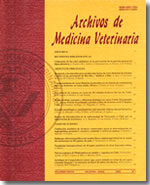Productive performance, nutrient intake and productivity at lambing of hair breed ewes supplemented with energy in the pre-partum during summer and winter
Main Article Content
Abstract
A total of 48 pregnant multiparous hair ewes were used to evaluate the effects of energy supplementation (100 and 125% of metabolizable energy) and season (summer and winter) on the productive performance and nutrient intakes during the last third of gestation, in an arid weather. Additionally, ewe productivity at lambing was studied. The experimental diets were offered from day 100 of pregnancy until lambing. Climatic conditions were heat stress in summer and thermoneutral in winter. The interaction supplementation x season was not significant (P > 0.05) for any variable. Compared with control, supplemented ewes presented higher (P < 0.05) intake of total digestible nutrients and metabolisable energy, likewise, higher (P < 0.05) daily weight gain and feed efficiency. Supplementation did not affect (P > 0.05) lamb birth weights and the ewe productivity at lambing. Moreover, ewes in winter had greater (P < 0.05) intake of nutrients, weight gain and feed efficiency compared with summer. At lambing, season did not affect (P > 0.05) lamb birth weights but whether (P < 0.05) the size and weight of litter. In conclusion, energy supplementation improved energy intakes, which was reflected in increased live weight for ewes, but without effect on lamb birth weights. The high summer temperatures reduced the ewe productivity as result of a low nutrient intake.

